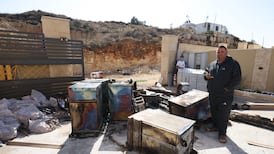US president Donald Trump’s Middle East envoy Steve Witkoff will meet Israeli minister of strategic affairs Ron Dermer and a senior Qatari envoy in Rome on Thursday, as part of his push to advance a Gaza ceasefire and hostage release deal to end the 21-month war.
If sufficient progress is made, it is expected that Witkoff will travel from Rome to Doha towards the end of the week to secure a deal, according to the well-informed Axios news website, citing a US and Israeli source.
Among the ebbs and flows of the negotiations over the last few weeks, and the conflicting reports of progress and deadlock, the one key sign indicating that an agreement might be close was if Witkoff would travel to the region.
A senior Israeli security official was quoted as saying: “We are in the midst of negotiations – really in the final stretch.”
READ MORE
Another indication that a deal may be within reach is the fact that the Israeli negotiating team has now been in Doha for proximity talks with a Hamas delegation for 2½ weeks – far longer than any period in the past when negotiations were taking place.
Under discussion is an initial 60-day ceasefire, during which 10 of the 20 hostages believed to be alive would be released and talks would begin on a permanent end to the war.
A few weeks ago Israeli prime minister Binyamin Netanyahu stressed the importance of the Israel Defense Forces (IDF) retaining control of the Morag corridor which divides Rafah at the southern tip of Gaza from Khan Younis, the enclave’s second-largest city. However, Hamas rejected the maps presented by Israeli negotiators and Israel has essentially backed down from the demand.
The impending truce agreement envisages an IDF withdrawal to virtually the same Gaza security perimeter that Israel held in January, a strip of 700-1,000 metres running along the Israel-Gaza border.

This prompts the question of why a ceasefire wasn’t reached many months ago, which would have saved the lives of many thousands of Gazans and dozens of Israeli soldiers and brought the hostages home.
Stepped-up American pressure is definitely a factor and Trump has made it crystal clear in recent months that he wants this war to end.
But Netanyahu’s domestic political considerations may also be a factor, although he will never admit to this.
The two far-right parties in Netanyahu’s coalition want the IDF to conquer the entire Gaza Strip, paving the way for a return of the Jewish settlements that were uprooted in the 2005 disengagement, when Israel pulled out all settlers and soldiers from the enclave.
Both parties threatened to withdraw from the coalition if Netanyahu agreed to end the war without what they termed a “total victory” over Hamas. Such a move could have brought down the government but the threat is no longer relevant. In a few days the Knesset parliament begins a three-month-long summer recess during which no-confidence motions cannot be submitted.
Netanyahu has a 90-day breathing space – an ideal time to clinch a ceasefire while his government remains intact. And a deal that brings about the release of all the 50 hostages – 20 believed alive and 30 believed dead – would be supported by the overwhelming majority of Israelis, and could provide the catalyst for new elections.
The Hamas-run Gaza health ministry says more than 59,000 people have been killed in the war, which began with the Hamas attack on southern Israel on October 7th, 2023, during which 1,200 people were killed and 250 taken hostage.














